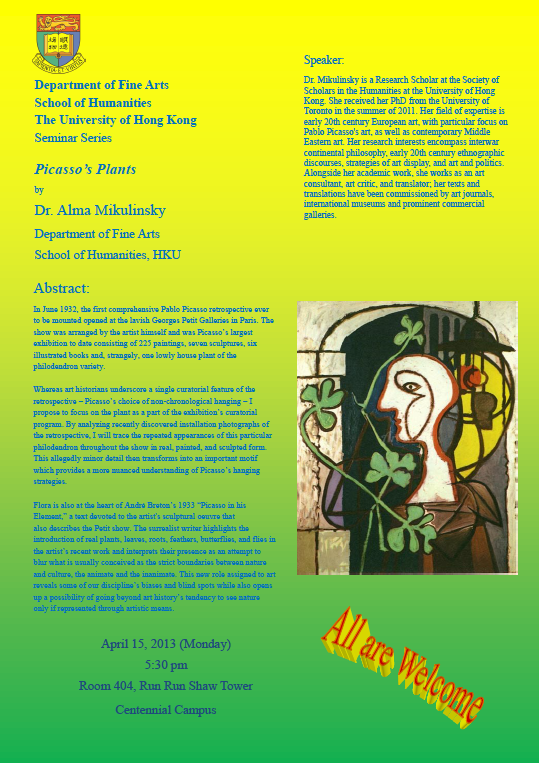

Picasso’s Plants
April 15, 2013 @ 5:30 pm - 7:00 pm
Picasso’s Plants
Date: 15 April 2013 (Monday)
Time: 5:30pm
Venue: Room 4.04, Run Run Shaw Tower, Centennial Campus
In June 1932, the first comprehensive Pablo Picasso retrospective ever to be mounted opened at the lavish Georges Petit Galleries in Paris. The show was arranged by the artist himself and was Picasso’s largest exhibition to date consisting of 225 paintings, seven sculptures, six illustrated books and, strangely, one lowly house plant of the philodendron variety.
Whereas art historians underscore a single curatorial feature of the retrospective – Picasso’s choice of non-chronological hanging – I propose to focus on the plant as a part of the exhibition’s curatorial program. By analyzing recently discovered installation photographs of the retrospective, I will trace the repeated appearances of this particular philodendron throughout the show in real, painted, and sculpted form. This allegedly minor detail then transforms into an important motif which provides a more nuanced understanding of Picasso’s hanging strategies.
Flora is also at the heart of André Breton’s 1933 “Picasso in his Element,” a text devoted to the artist’s sculptural oeuvre that also describes the Petit show. The surrealist writer highlights the introduction of real plants, leaves, roots, feathers, butterflies, and flies in the artist’s recent work and interprets their presence as an attempt to blur what is usually conceived as the strict boundaries between nature and culture, the animate and the inanimate. This new role assigned to art reveals some of our discipline’s biases and blind spots while also opens up a possibility of going beyond art history’s tendency to see nature only if represented through artistic means.
Speaker: Alma Mikulinsky
Dr. Mikulinsky is a Research Scholar at the Society of Scholars in the Humanities at the University of Hong Kong. She received her PhD from the University of Toronto in the summer of 2011. Her field of expertise is early 20th century European art, with particular focus on Pablo Picasso’s art, as well as contemporary Middle Eastern art. Her research interests encompass interwar continental philosophy, early 20th century ethnographic discourses, strategies of art display, and art and politics. Alongside her academic work, she works as an art consultant, art critic, and translator; her texts and translations have been commissioned by art journals, international museums and prominent commercial galleries.



Find us on…